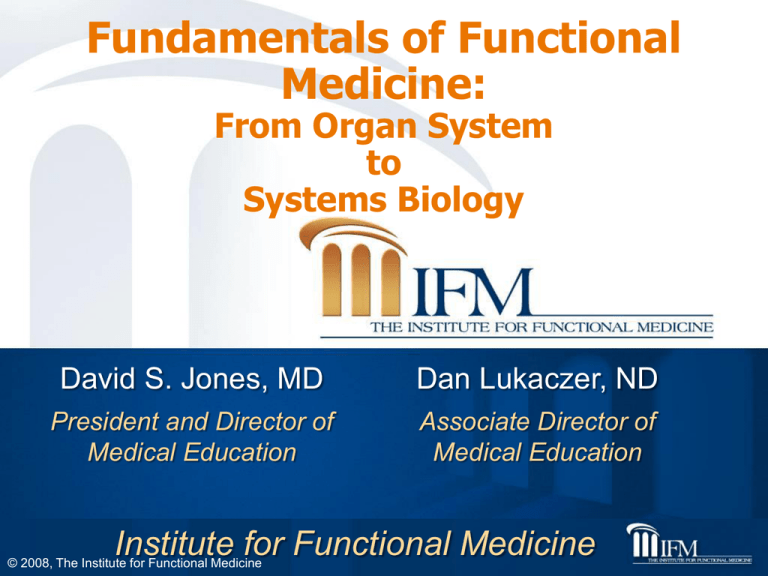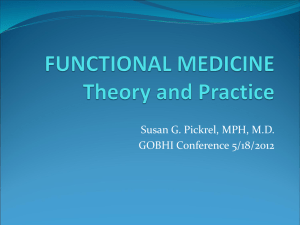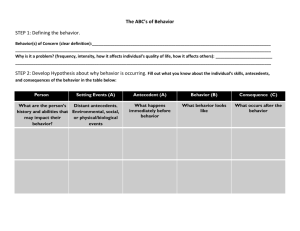Title of presentation goes here - Institute for Functional Medicine
advertisement

Fundamentals of Functional Medicine: From Organ System to Systems Biology David S. Jones, MD Dan Lukaczer, ND President and Director of Medical Education Associate Director of Medical Education Institute for Functional Medicine © 2008, The Institute for Functional Medicine David Jones MD © 2008, The Institute for Functional Medicine Dan Lukaczer ND Functional Medicine is personalized medicine that deals with primary prevention and underlying causes instead of symptoms for serious chronic disease © 2008, The Institute for Functional Medicine THE UNMET NEED Chronic Disease: The Need for a New Clinical Education “It is axiomatic that medical education should prepare students well for the clinical problems they will face in their future practice. However, that is not happening for the most prevalent problem in health care today: chronic disease.” “Chronic disease replaced acute disease as the dominant health problem. Chronic disease is now the principal cause of disability and use of health services and consumes 78% of health expenditures.” Holman H. JAMA. 2004;292:1057-1059. © 2008, The Institute for Functional Medicine THE UNMET NEED “The Future of Family Medicine Report calls for a New Model of care that is grounded in timeless values of personalized, patientcentered care coupled with the application of new technologies and systems.” Stange KC. Ann Fam Med. 2006;4:98-100 © 2008, The Institute for Functional Medicine ESSENTIAL COMPONENTS FOR FUNCTIONAL MEDICINE PRACTITIONER COGNITIVE SKILLS NEEDED: • An analytical, iterative process of careful construction & clinical response • A disciplined methodology of organizing information for more comprehensive evaluation and treatment of chronic illness • Reframing of patient’s story to reflect antecedents, triggers & mediators • Integration of intellectual curiosity, academic rigor, and the use of pattern recognition to improve clinical judgment • Facile in the use of the FM Matrix for organizing and understanding the indicators of dysfunction © 2008, The Institute for Functional Medicine ESSENTIAL COMPONENTS FOR FUNCTIONAL MEDICINE PRACTITIONER PATIENT-CENTERED CLINICAL SKILLS • Primacy of therapeutic partnership & patient empowerment • Eliciting and then retelling the patient’s story using the ATM (antecedents, triggers & mediators) model • Understand the application of “readiness to change” models for establishing patient rapport • Use of appropriate functional medicine assessment procedures for clinical assessment • Use of core therapeutics including: nutritional/dietary interventions, physical medicine, toxin avoidance and mitigation, mind-body-spirit interventions, bioenergetic treatments, appropriate use of drugs and surgery © 2008, The Institute for Functional Medicine THE UNMET NEED The need is for a new kind of CHRONIC CARE TEAM Physicians who approach disease from a systems biology perspective rather than organ system taxonomy Nutritionists/dietitians who can evaluate & educate patients for their nutritional status, cellular health and design nutritional programs Practitioners skilled in structural, exercise, and bioenergetics principles Biologic-Functional dentists skilled in non-toxic restoration of dental/oral function Pharmacists who can compound Rxs specific to the patient’s need Psychologists/mind-body-spirit practitioners skilled in training patients in techniques for achieving and maintaining wholeness Para-medical practitioners skilled in specific functional practices © 2008, The Institute for Functional Medicine FUNCTIONAL MEDICINE: A Patient-Centered, Comprehensive Chronic-Care Model © 2008, The Institute for Functional Medicine © 2007 THE PRINCIPLES: A SCIENCE USING FIELD OF HEALTHCARE Biochemical individuality based on genetic and environmental uniqueness Patient centered versus disease centered Dynamic balance of internal and external factors Web-like interconnections of physiological factors Health as a positive vitality – not merely the absence of disease Promotion of organ reserve – healthspan Textbook of Functional Medicine: Chap 2 © 2008, The Institute for Functional Medicine At the heart At the heartlies the of medicine of medicine lies the individual and each each individual and patient’s unique story… patient’s unique story… © 2008, The Institute for Functional Medicine That Story Is Typically Told As … Chief Complaint (CC) History of Present Illness (HPI) Past Medical History (PMH) Review of Organ Systems (RS) Family History (FH) Dietary History (DH) Medication and Supplement History Social, Lifestyle, and Exercise History Physical Exam Findings (PE) Laboratory and Imaging Evaluations Assessment and Diagnosis © 2008, The Institute for Functional Medicine In conventional medicine, the primary aim is to arrive quickly at the diagnosis. This emphasis on diagnosis is particularly critical in the acute-care setting; rapid diagnosis leads to rapid treatment. Treatment in this setting must be prompt, as it is often designed to “lock down” and control physiology. The chief complaint and history of the present illness become the critical aspects of the story; the rest of the patient’s story is often truncated when other information is seen as superfluous to reaching the diagnosis. © 2008, The Institute for Functional Medicine In acute care, the patient’s story is squeezed down to the chief complaint and history of the present illness while the diagnosis increases in importance. © 2008, The Institute for Functional Medicine Example #1 Chief Complaint: Wheezing History of Present Illness sudden asthmatic onset history tightness in shortness of the chest breath Diagnosis: Acute Asthma Attack bronchodilators © 2008, The Institute for Functional Medicine corticosteroids oxygen Problems arise when the acute-care model is used to address chronic, long-term health issues. The clinician proceeds directly to the diagnosis—naming the disease—in order to identify as quickly as possible a medication to treat that disease. © 2008, The Institute for Functional Medicine The Story Is Truncated Chief Complaint History of Present Illness Past Medical History Review of Organ Systems Family History Dietary History Medication and Supplement History Social, Lifestyle, and Exercise History Physical Exam Findings Laboratory and Imaging Evaluations Assessment DIAGNOSIS BY ORGAN SYSTEM © 2008, The Institute for Functional Medicine THE RESULTS OF USING THE ACUTE CARE MODEL: Little attention is paid to the patient’s story beyond the chief complaint and history of the present illness. The patient’s whole story is not understood. Each major issue becomes a discrete diagnosis, dealt with in isolation from the others. © 2008, The Institute for Functional Medicine Dicyclomine NSAID Irritable Bowel Syndrome Osteoarthritis ACE inhibitor Hypertension … the result is a focus on treating each symptom complex as a separate and distinct “disease” with a separate and distinct treatment. Hypercholesterolemia Depression Gastroesophageal Reflux Disease SSRI H2 blocker © 2008, The Institute for Functional Medicine Migraines Statin Triptan Dicyclomine NSAID Irritable Bowel Syndrome Osteoarthritis ACE inhibitor Each individual diagnosis becomes a distinct entity unto itself. The patient’s whole story never has a chance to be heard and understood in context. Hypertension Depression Gastroesophageal Reflux Disease Hypercholesterolemia Statin SSRI H2 blocker © 2008, The Institute for Functional Medicine Migraines Triptan It is apparent that—in its rush to diagnose— conventional medicine is focused on the branches Pulmonary Cardiology andEndocrinology leaves of theUrology/Nephrology tree … Gastroenterology Neurology Organ System Diagnosis Hepatology Allergy Signs and Symptoms and not the trunk and roots 21st Century Medicine Systems Biology Diagnosis © 2008, The Institute for Functional Medicine Cardiology Pulmonary Urology/Nephrology Endocrinology Hepatology Gastroenterology Organ System Diagnosis Neurology Allergy Signs and Symptoms Mind and Spirit Genetic Predisposition Experiences, Attitudes, Beliefs Psychosocial © 2008, The Institute for Functional Medicine Physical Exercise, Trauma Diet, Nutrients, Air/Water Environmental Inputs Xenobiotics, Micro-organisms, Radiation Cardiology Pulmonary Urology/Nephrology Endocrinology Hepatology Gastroenterology Organ System Diagnosis Neurology Allergy Signs and Symptoms Fundamental Physiological Processes 1. Communication - Outside the cell - Inside the cell 2. Bioenergetics/Energy Transformation 3. Replication/Repair/Maintenance/ Structural Integrity 4. Elimination of Waste 5. Protection/Defense 6. Transport/Circulation Mind and Spirit Genetic Predisposition Experiences, Attitudes, Beliefs Psychosocial Physical Exercise, Trauma Diet, Nutrients, Air/Water Environmental Inputs © 2008, The Institute for Functional Medicine Xenobiotics, Micro-organisms, Radiation Cardiology Pulmonary Urology/Nephrology Endocrinology Hepatology Gastroenterology Organ System Diagnosis Neurology Allergy Signs and Symptoms Fundamental Clinical Imbalances 1. 2. 3. 4. 5. 6. 7. Immune and Inflammatory Imbalance Redox Imbalance + Oxidative Stress + Mitochondropathy Digestive/Absorptive and Microbiological Imbalance Detox/Biotransformation/Excretory Imbalance Structural /Membrane Imbalance Hormonal and Neurotransmitter Imbalances Psychological and Spiritual Imbalance Fundamental Physiological Processes 1. Communication 2. Bioenergetics/Energy 4. Elimination of Waste Transformation - Outside the cell 5. Protection/Defense - Inside the cell 3. Replication/Repair/Maintenance/ 6. Transport/Circulation Structural Integrity Mind and Spirit Genetic Predisposition Psychosocial © 2008, The Institute for Functional Medicine Experiences, Attitudes, Beliefs Physical Exercise, Trauma Diet, Nutrients, Air/Water Environmental Inputs Xenobiotics, Micro-organisms, Radiation Core Clinical Imbalances Hormonal and neurotransmitter imbalances Oxidation-reduction imbalances and mitochondropathy Detoxification and biotransformational imbalances Immune and inflammatory imbalances Digestive, absorptive, and microbiological imbalances Structural imbalances from cellular membrane function to the musculoskeletal system Mind-body/body-mind imbalances © 2008, The Institute for Functional Medicine These fundamental clinical imbalances are the underlying mechanisms of disease … Immune Surveillance and Inflammatory Process Oxidative/Reductive Homeodynamics Digestion and Absorption Detoxification and Biotransformation Structural/Boundary and Membranes Hormone and Neurotransmitter Regulation Psychological and Spiritual Equilibrium © 2008, The Institute for Functional Medicine In the functional medicine model, the patient’s full story is of central importance. Instead of a preoccupation with how to name the disease, the critical questions become: Where does the symptom come from? That is, what are the antecedents and triggers? What keeps it going? That is, what are the mediators? And what can be done to change that dis-eased allostatic balance point the patient is locked into? That is, what are the underlying points of leverage where intervention can be most effective? © 2008, The Institute for Functional Medicine Fundamental Approach Triggers Affecting Antecedents (predisposing factors) Sending out signals as Mediators Creating Imbalance/Dis-ease © 2008, The Institute for Functional Medicine Antecedents (genetics, experiences, past illnesses, occupational exposure, nutrition, lifestyle) Triggers (microbes, allergens, trauma, toxins) Biological Mediators (cytokines, prostanoids, nitric oxide, kinins, hormones, neurotransmitters, free radicals) © 2008, The Institute for Functional Medicine Feedforward cycle These fundamental clinical imbalances are the underlying mechanisms of disease … Immune Surveillance and Inflammatory Process Oxidative/Reductive Homeodynamics Digestion and Absorption Detoxification and Biotransformation Structural/Boundary and Membranes Hormone and Neurotransmitter Regulation Psychological and Spiritual Equilibrium The diagnosis becomes a systems biology assessment © 2008, The Institute for Functional Medicine The Functional Medicine Story Is Developed with a Different Focus Chief Complaint (CC) History of Present Illness (HPI) Antecedents, Triggers, and Mediators Past Medical History (PMH) Review of Organ Systems (RS) Family History (FH) Dietary History Medication and Supplement History Social, Lifestyle, and Exercise History Physical Exam Findings Laboratory and Imaging Evaluations Diagnosis by Organ System Disease DIAGNOSIS of Fundamental Clinical Imbalances (Systems Biology) © 2008, The Institute for Functional Medicine Counseling Exercise Prescriptions Phytonutrients Compounded, Personalized Prescriptions Meditation The expanded Functional Medicine Model permits the clinician to choose from an enlarged tool kit of therapies because the patient’s problems are seen from a perspective of underlying mechanisms of imbalance. Drugs Surgery Personalized Diet Interventions Yoga Manipulative Therapies Acupuncture Nutritionals: Vitamins & Minerals Nutraceuticals © 2008, The Institute for Functional Medicine Functional medicine should not be viewed as alternative medicine, but as a bridge to a more effective chronic-care model. © 2008, The Institute for Functional Medicine Let’s Explore How to Use the Functional Medicine Matrix ® Model © 2008, The Institute for Functional Medicine Functional Medicine ‘Expands the Accordion’ In Functional Medicine, the goal is to expand the patient’s story sufficiently to clarify the often multiple dysfunctions that must be addressed. For patients with chronic, complex illnesses, the ‘accordion file’ of the patient history is opened out to evaluate the important antecedents, triggers and mediators, and to clarify the underlying mechanisms of dysfunction © 2008, The Institute for Functional Medicine In complex chronic disease there is often significant information buried in the story © 2008, The Institute for Functional Medicine Cardiology Pulmonary Endocrinology Gastroenterology Urology/Nephrology Hepatology Organ System Diagnosis Neurology Allergy Signs and Symptoms Fundamental Clinical Imbalances Hormonal and Neurotransmitter Imbalances Redox Imbalance + Oxidative Stress + Mitochondropathy Detox/Biotransformation/Excretory Imbalance Immune Imbalance Inflammatory Imbalance Digestive/Absorptive and Microbiological Imbalance Structural Integrity Imbalance Fundamental Physiological Processes 1. Communication - Outside the cell - Inside the cell 2. Bioenergetics/Energy Transformation 3. Replication/Repair/Maintenance/ Structural Integrity 4. Elimination of Waste 5. Protection/Defense 6. Transport/Circulation Mind and Spirit Genetic Predisposition Experiences, Attitudes, Beliefs Psycho-social © 2008, The Institute for Functional Medicine Physical Exercise Trauma Diet, Nutrients, Air/Water Environmental Inputs Xenobiotics Microorganisms Radiation Functional Medicine focuses on antecedents, triggers and mediators Antecedents are factors, genetic or acquired, that predispose to illness Triggers are factors that provoke the symptoms and signs of illness Mediators are factors, biochemical or psychosocial, that contribute to pathological changes and dysfunctional responses © 2008, The Institute for Functional Medicine And the Core Clinical Imbalances These core clinical imbalances underlie the expression of disease These clinical imbalances form a pattern of dysfunction and are the result of underlying antecedents, triggers and mediators It is the recognition of these patterns that is the art and science of medicine © 2008, The Institute for Functional Medicine FUNCTIONAL MEDICINE MATRIX MODEL™ Immune Surveillance and Inflammatory Process Oxidative/Reductive Homeodynamics Detoxification and Biotransformation The Patient’s Story Retold Digestion Antecedents and Absorption (Predisposing) _____________________ ____________________ _____________________ ____________________ _____________________ ____________________ Hormone and Neurotransmitter Regulation Triggering Events Structural/Boundary/ Membranes (Activation) __________________ __________________ __________________ __________________ __________________ __________________ Nutrition Status Exercise Sleep Beliefs & Self-Care Psychological and Spiritual Equilibrium Relationships Date: ____ Name: ___________________ Age _____ Sex______ Chief Complaints: ___________________________ © 2008, The Institute for Functional Medicine Case Study Progression Take a careful, ‘expanded’ case Assess signs and symptoms in the case and filter to appropriate clinical imbalances Evaluate for the most important antecedents, triggers and mediators Prioritize the clinical imbalances in the case (pattern recognition) From this prioritization, decide what further evaluation would be useful Explain and frame the story to the patient based upon the matrix; with antecedents, triggers, mediators and prioritizations © 2008, The Institute for Functional Medicine Case Example Chief Complaint/History of PI 32 year old white male with a lifelong history of irritable bowel syndrome. Multiple work-ups as a child with little relief. 5 years ago he was diagnosed by stool exam with Blastocystis hominis and intestinal yeast. Treated with lactobacillus and Flagyl and reported significant improvement. (No follow-up lab performed) However, over the course of 6-12 months his digestive symptoms returned. Currently he experiences episodic gas, bloating, and intermittent diarrhea. © 2008, The Institute for Functional Medicine Past Medical History Adult onset asthma started about 6 years ago. Prescribed multiple inhalers and antihistaminics with improvement. Relatively asymptomatic until the last 6 months during which he has had 3 asthmatic attacks unresponsive to bronchodilators. Placed on prednisone dose packs on three occasions. Currently mildly symptomatic. Multiple antibiotics as child for ear and throat infections. History of depression (and past treatment) but not currently on pharmacological treatment. © 2008, The Institute for Functional Medicine Family History/Dietary History Family history : • Paternal: asthma and chronic sinusitis • Maternal: obesity Dietary history: Typical standard American diet (SAD): high in simple carbohydrates Often has fast food for lunch and dinner Drinks 3-5 cups of caffeinated beverages daily Does not eat fish or other significant sources of Omega 3 oils © 2008, The Institute for Functional Medicine Supplement and Medication History Prescriptive medications: Proventil prn Non prescriptive medications and supplements: Aspirin 2-3x weekly for headaches Tums 2-3x weekly for indigestion © 2008, The Institute for Functional Medicine Lifestyle, Social, and Exercise History Lives alone Works as a physician and has inconsistent and long work hours; little social life and few hobbies. No regular aerobic exercise. Occasionally uses a Stairmaster (1-2 times/weekly) for 30 minutes. No resistive training. Does not smoke or drink. No other recreational drug use. © 2008, The Institute for Functional Medicine Physical Exam/ Laboratory Evaluation Physical Exam: 70” 175# BP 130/86 EENT: Nasal mucosa boggy and edematous. Slight erythema noted in posterior pharynx. Skin: dry in general, posterior arms have cobble-stone texture. Fingernails have multiple white spotting. Rest of physical exam is non-contributory Previous Laboratory : CBC, Chemistry panel within normal limits © 2008, The Institute for Functional Medicine Clarify the most important antecedents, triggers and mediators in the case © 2008, The Institute for Functional Medicine Assessing for Potential Antecedents, Triggers and Mediators Antecedents: Triggers: Multiple antibiotics Genetic atopic propensity Blastocystis hominis, Food sensitivity, Dysbiosis Mediators: Medications: Aspirin- increase in intestinal permeability Medication: Proventil-increase Detox load Adiposity-increased inflammatory mediators Depression-hormonal GI effects Nutritional insufficiencies: multiple effects on immune competence, intestinal permeability etc. © 2008, The Institute for Functional Medicine Prioritize the clinical imbalances in the case (pattern recognition): © 2008, The Institute for Functional Medicine Is Blastocystis a pathogen? Clinical Significance of Blastocystis hominis J Clin Micro 1989;Nov:2407-2409 Screening of a large population group for protozoa infection revealed that 515 were infected with the single protozoa Blastocystis hominis. However, only 239 (46%) were found to be symptomatic, suggesting differential pathogenicity. 43 of these symptomatic patients were treated with Metronidazole. All patients became asymptomatic with negative stools on follow-up. © 2008, The Institute for Functional Medicine Does Blastocystis increase intestinal permeability? Protozoon infections and intestinal permeability. Acta Trop. 2002 Jan;81(1):1-5. Thirty nine patients with protozoan infections were compared to ten healthy controls. Intestinal permeability (IP) was found to be increased in patients with protozoan infections compared with the control patients; specifically IP was increased in the Giardia and Blastocystis groups, although not in Entamoeba coli group. The increase in IP in patients with B. hominis suggests that it can be a pathogenic protozoal infection and have systemic consequences © 2008, The Institute for Functional Medicine Healthy Gut Healthy Villi/ Good Absorption Healthy Cell Junctions © 2008, The Institute for Functional Medicine Leaky Gut Damaged Villi / Poor Absorption Damaged Cell Junctions © 2008, The Institute for Functional Medicine Leaky Gut - Pathophysiology Poor Dietary Choices Stress & Emotions Infection Lectins Systemic Disease Altered Intestinal Permeability Food Allergy Malnutrition Elevated Total Toxic & Antigenic Burden Dysbiosis Low Stomach Acid Toxic Exposure © 2008, The Institute for Functional Medicine Toxic Overload Systemic Disease Is intestinal permeability linked to asthma? Intestinal permeability is increased in bronchial asthma. Arch Dis Child. 2004 Mar;89(3):227-9. Thirty two asthmatic children, and 32 sex and age matched controls were assessed using the dual sugar (lactulose and mannitol) test. Intestinal permeability was increased in children with asthma, suggesting that the whole mucosal system may be affected. Previous reports have shown increased intestinal permeability in adult asthmatics. © 2008, The Institute for Functional Medicine FUNCTIONAL MEDICINE MATRIX MODEL™ Immune Surveillance and Inflammatory Process Oxidative/Reductive Homeodynamics Food allergen Yeast sensitivity Zinc insufficiency EFA Insufficiency Excess adiposity Genetic propensity Digestion and Absorption Increased intestinal permeability secondary to? Dysbiosis Protozoa infection Structural/Boundary/ Membranes Nutrition Status Detoxification and Biotransformation Medications The Patient’s Story Retold Hormone and Neurotransmitter Regulation Antecedents (Predisposing) Multiple antibiotics Genetic atopic propensity History of Depression Triggering Events (Activation) IBS trigger: B. hominis, Food sensitivity Asthma trigger: B. hominis, Food sensitivity Overweight, Depression Medications: Aspirin Nutritional insufficiencies: zinc, etc Exercise Sleep Beliefs & Self-Care Psychological and Spiritual Equilibrium History of Depression, Little Social Life, Lives Alone Relationships Date: ____ Name: ___________________ Age _____ Sex______ Chief Complaints: ___________________________ © 2008, The Institute for Functional Medicine further evaluation to consider? © 2008, The Institute for Functional Medicine Case Study Progression Reflecting back the patient’s story: Explain and frame the story back to the patient based upon the matrix. Start with the antecedents to the chief complaint(s) and review the important triggers and mediators that build on that story. Emphasize the main elements of the matrix in the story. The objective is to accurately and concisely reflect a story that a patient can understand. © 2008, The Institute for Functional Medicine FUNCTIONAL MEDICINE MATRIX MODEL™ Immune Surveillance and Inflammatory Process Food antibodies Yeast antibodies Bioelectrical impedance RBC Fatty Acids WBC zinc SNP assessment Digestion and Absorption O&P Lactulose Mannitol Digestive function Structural/Boundary/ Membranes Oxidative/Reductive Homeodynamics Detoxification and Biotransformation The Patient’s Story Retold Antecedents (Predisposing) _____________________ ____________________ _____________________ ____________________ _____________________ ____________________ Hormone and Neurotransmitter Regulation Amino Acid analysis Triggering Events (Activation) __________________ __________________ __________________ __________________ __________________ __________________ Nutrition Status Exercise Sleep Beliefs & Self-Care Psychological and Spiritual Equilibrium Relationships Date: ____ Name: ___________________ Age _____ Sex______ Chief Complaints: ___________________________ © 2008, The Institute for Functional Medicine Initial Intervention • Comprehensive elimination diet • Non dairy/non gluten functional food containing: • supplemental antioxidants • conditional essential nutrients for GI tract • anti-inflammatory nutrients and phytonutrients • O&P X 3 © 2008, The Institute for Functional Medicine 5 week follow-up • • • • Considerable improvement in IBS with a decrease in gas, bloating, and decreased frequency of episodic diarrhea. Decreased asthmatic complaints. Overall ≈ 50% improved Laboratory Results: • O and P: • Microscopy: • • Rare endolimax nana cysts and trophozoites • Many Blastocystis hominis EIA Giardia, Cryptosporidium, and Entamoeba negative © 2008, The Institute for Functional Medicine “A therapeutic intervention is fitting the treatment to the individual. In that sense it is like tailoring … measuring and trying it on until you get a good fit…. You don’t always get it the first time.” Sid Baker, MD © 2008, The Institute for Functional Medicine 5 week follow-up Continue on dietary and functional/medical food protocol. Add: • Botanical anti-protozoal therapy: berberine, artemesia, and citrus seed extract in combination • Probiotics: lactobacillus and bifidobacteria in combination © 2008, The Institute for Functional Medicine Can probiotics affect intestinal permeability? Probiotics in the atopic march: highlights and new insights Dig Liver Dis. 2006 Dec;38 Suppl 2:S288-90. Probiotics positively affect the host by enhancing the microbial balance and therefore restore the normal intestinal permeability and gut micro ecology. In clinical trials probiotics appear to be useful for the treatment of various clinical conditions such as food allergy, AD and allergic rhinitis, It may be possible, in the future, to use probiotics in primary prevention of asthma. © 2008, The Institute for Functional Medicine 12 week follow-up Asthma and IBS essentially asymptomatic Food reintroduction showed sensitivity to caffeine, chocolate, and eggs. Further consideration would include continuation of reinoculation and repair of gastrointestinal system and rotation diet. To discontinue functional/medical food and antiparasitic protocol. F/u O&P: negative © 2008, The Institute for Functional Medicine “It is much more important to know what sort of person has a disease, than what sort of disease a person has.” Sir William Osler © 2008, The Institute for Functional Medicine FUNCTIONAL MEDICINE MATRIX MODEL™ Immune Surveillance and Inflammatory Process Oxidative/Reductive Homeodynamics Detoxification and Biotransformation The Patient’s Story Retold Digestion Antecedents and Absorption (Predisposing) _____________________ ____________________ _____________________ ____________________ _____________________ ____________________ Hormone and Neurotransmitter Regulation Triggering Events Structural/Boundary/ Membranes (Activation) __________________ __________________ __________________ __________________ __________________ __________________ Nutrition Status Exercise Sleep Beliefs & Self-Care Psychological and Spiritual Equilibrium Relationships Date: ____ Name: ___________________ Age _____ Sex______ Chief Complaints: ___________________________ © 2008, The Institute for Functional Medicine








